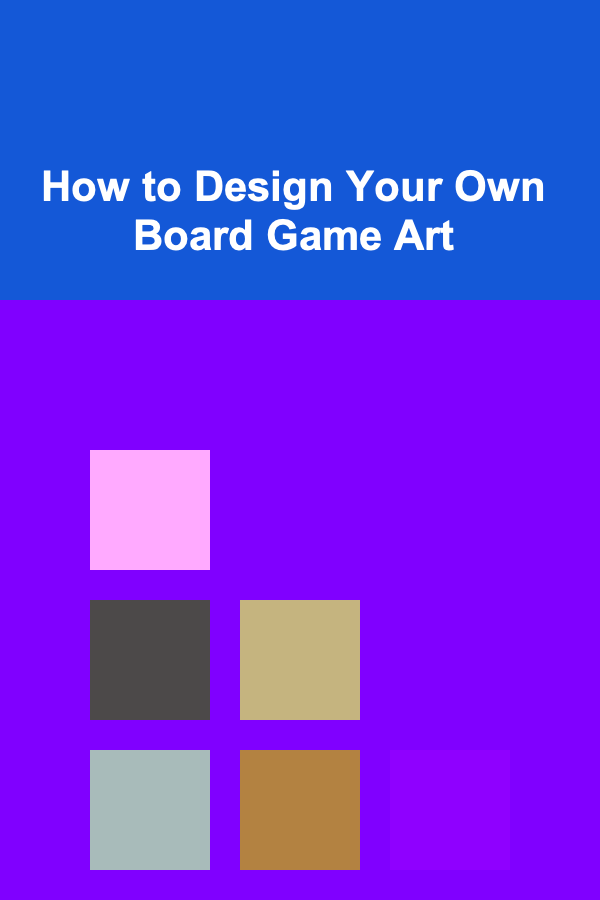
How to Design Your Own Board Game Art
ebook include PDF & Audio bundle (Micro Guide)
$12.99$10.99
Limited Time Offer! Order within the next:

Designing art for a board game is an exciting yet challenging process that requires creativity, technical skill, and an understanding of the game's mechanics, theme, and target audience. Board game art plays a significant role in shaping the player experience, creating an immersive world, and conveying the mood and feel of the game. Whether you are designing a simple card game or a complex strategy game, the artwork can elevate the game from a mechanical experience to a compelling journey.
In this guide, we will explore the steps involved in designing board game art, from conceptualization to the final polished product. We'll cover important considerations such as art styles, visual consistency, and how to collaborate with artists or create the art yourself. By the end of this article, you'll have a clear understanding of the role of art in board games and the skills required to bring your vision to life.
Understand the Game's Theme and Mechanics
Before diving into the art design, it's essential to have a deep understanding of your board game's theme and mechanics. The artwork should not only look aesthetically pleasing but also reinforce the game's mechanics and story.
a) Game Mechanics and Playability
The way your game is played will influence how the art interacts with it. For example, a game with a heavy focus on combat may require dynamic and action-packed artwork to convey the intensity of the gameplay. On the other hand, a strategy game may benefit from subtle, thought-provoking visuals that reflect the complexity of the decision-making process.
b) Game Theme and Story
Your board game's theme sets the tone for the entire project. A fantasy game will have vastly different artwork compared to a historical or futuristic game. The artwork should visually communicate the setting and narrative, helping players immerse themselves in the world you've created. Understanding your theme is also important in choosing the appropriate art style. For instance, a lighthearted game may benefit from colorful, cartoonish illustrations, while a darker, more serious game may need a more realistic, detailed approach.
c) Target Audience
The audience you're designing for will greatly influence your art style. A family-friendly game will often require more accessible and colorful artwork, whereas a game aimed at enthusiasts or hobbyists may call for more intricate designs. Understanding who will be playing your game will help you decide on the tone, complexity, and artistic direction.
Choose an Art Style
Selecting the right art style is a pivotal decision in board game design. The art style will define the look and feel of your game and should complement its theme and mechanics.
a) Traditional Art Styles
- Realism: This style strives to portray subjects as accurately and lifelike as possible. It works well for historical games, simulation games, or games where realism enhances the experience.
- Fantasy/Illustrative: A commonly used style in fantasy games, where the art is often whimsical and detailed. It can range from a more realistic depiction of fantastical creatures to a more stylized, painterly approach.
- Cartoon/Comic: This style is often bold, playful, and exaggerated. It works well for family or casual games, offering vibrant, accessible visuals that are easy to digest.
b) Contemporary Art Styles
- Minimalist: Using as few elements as possible to communicate a message. It's a modern approach and can be used for abstract or puzzle-based games, where the focus is more on simplicity and clarity.
- Abstract: Often used in artistic or conceptual games, this style focuses more on shapes, patterns, and color theory rather than direct representations of the game world.
- Vintage or Retro: This style can evoke a sense of nostalgia or take inspiration from earlier art movements, often used in games that are trying to emulate a specific time period or style.
c) Consistency Across Game Elements
When choosing your art style, consistency is key. The game board, cards, tokens, and box cover should all share the same visual language. This doesn't mean that every element must look identical, but the style, color palette, and mood should be unified.
Conceptualize Your Artwork
Once you've defined the overall art style, it's time to conceptualize the individual game elements. This is where the bulk of the creative process happens, and it involves brainstorming and iterating on your ideas.
a) Game Board and Layout
The game board is often the centerpiece of the game's visual appeal. It's crucial to think about how the layout will support the game mechanics while maintaining visual clarity. For example, if your game involves movement, make sure there is enough space between areas for pieces to move. The board should visually guide players through the game's stages and help them understand the progression.
b) Card Design
Cards are a major part of many board games, and they need to balance readability with creativity. The illustrations on the cards should not overwhelm the information they need to convey. It's essential to create a clear, consistent layout where the artwork complements the text and mechanics. A good way to achieve this is by ensuring there is a clear visual hierarchy and that important elements are emphasized without too much clutter.
c) Tokens and Pieces
Game pieces, such as tokens, meeples, and dice, are another critical part of the visual experience. The design of these elements should complement the overall art style. Whether you are designing custom tokens or working with pre-made ones, consider their material, color, and how they will function within the game.
d) Iconography
Board games often require symbols or icons to represent different actions, conditions, or resources. Iconography should be clear, intuitive, and consistent across all game components. Each icon should be easy to understand and should not require excessive explanation.
Sketching and Prototyping
With your ideas and concepts in place, it's time to begin sketching out the designs. This process involves creating rough drafts of your artwork to explore how the various elements fit together and to refine your concepts.
a) Rough Sketches
Start by sketching out rough concepts for each component. These can be basic pencil sketches or digital mock-ups. Don't worry about making them perfect at this stage---this is all about refining the layout and ensuring the components work together. Keep the game's mechanics and functionality in mind while designing.
b) Test Prototypes
Once your sketches are complete, it's time to create some test prototypes. These don't have to be final, polished designs, but they should allow you to visualize how the art and game mechanics come together. Print out mock versions of the board, cards, and pieces to test with friends or potential players.
c) Iteration and Refinement
Game design is an iterative process. After testing your prototypes, gather feedback, and refine the designs. This might mean tweaking the art style slightly, adjusting colors for clarity, or simplifying elements for ease of use.
Collaboration with Artists
If you're not an artist yourself, you might need to collaborate with a professional illustrator or graphic designer. Working with artists can be a highly rewarding experience, but it's important to communicate your vision clearly and effectively.
a) Finding the Right Artist
Search for an artist whose style aligns with your game's concept. If your game has a fantasy theme, look for an artist with experience in that genre. Many artists specialize in specific art styles, so choosing the right one is critical. Platforms like Behance, DeviantArt, or even Kickstarter can help you find talented artists who are open to freelance work.
b) Clear Communication
Once you've selected an artist, communication is key. Be specific about your vision, providing references, sketches, and detailed descriptions. Discuss your expectations in terms of style, mood, color palette, and level of detail. Make sure you and your artist are on the same page before they begin work on the final illustrations.
c) Art Direction and Feedback
Throughout the process, provide constructive feedback on the artwork. Keep in mind that art is subjective, and some back-and-forth is inevitable. Provide clear, actionable feedback and work with the artist to refine the designs until they align with your vision.
Finalizing the Art Assets
Once the artwork has been created and approved, it's time to finalize the art assets for production. This step involves preparing the files and ensuring they are ready for printing.
a) Preparing for Print
The artwork needs to be prepared in a way that is suitable for print. This includes ensuring that the resolution is high enough, that the color profiles are correct, and that the file formats meet the requirements of the manufacturer. Be mindful of bleed areas, safe zones, and other printing considerations to avoid issues during production.
b) Digital Assets for Online Use
If you plan to sell your game online or promote it through digital platforms, you'll need digital assets like images for your game's website, social media, and online marketplaces. These assets should be optimized for web use and should align with your game's overall branding and aesthetic.
c) Final Review
Before sending your files to production, review all the artwork once again. Check for any inconsistencies, errors, or things that may have been missed. A final review ensures that everything is polished and ready for print.
Conclusion
Designing your own board game art is a complex but rewarding process that involves creativity, strategy, and collaboration. The artwork plays a significant role in the success of a game, influencing both the player experience and the overall impression of the game. By understanding the theme, mechanics, and target audience, choosing the right art style, and collaborating with talented artists, you can create a visually stunning board game that captivates players and enhances their gaming experience. Whether you're designing your own art or working with others, the key to success is clarity, consistency, and iteration. With patience and effort, you can bring your vision to life and create a board game that players will love.

How to Create a Family Time Capsule and Bury It Together
Read More
How to Soundproof Your Home for Ultimate Privacy
Read More
How to Use Baskets and Bins for Outdoor Toy Storage
Read More
How to Use Copywriting Expertise to Make Money
Read More
How to Price Your Digital Marketing Strategy Services
Read More
How to Identify Ancient Pottery Shards: A Beginner's Guide
Read MoreOther Products

How to Create a Family Time Capsule and Bury It Together
Read More
How to Soundproof Your Home for Ultimate Privacy
Read More
How to Use Baskets and Bins for Outdoor Toy Storage
Read More
How to Use Copywriting Expertise to Make Money
Read More
How to Price Your Digital Marketing Strategy Services
Read More